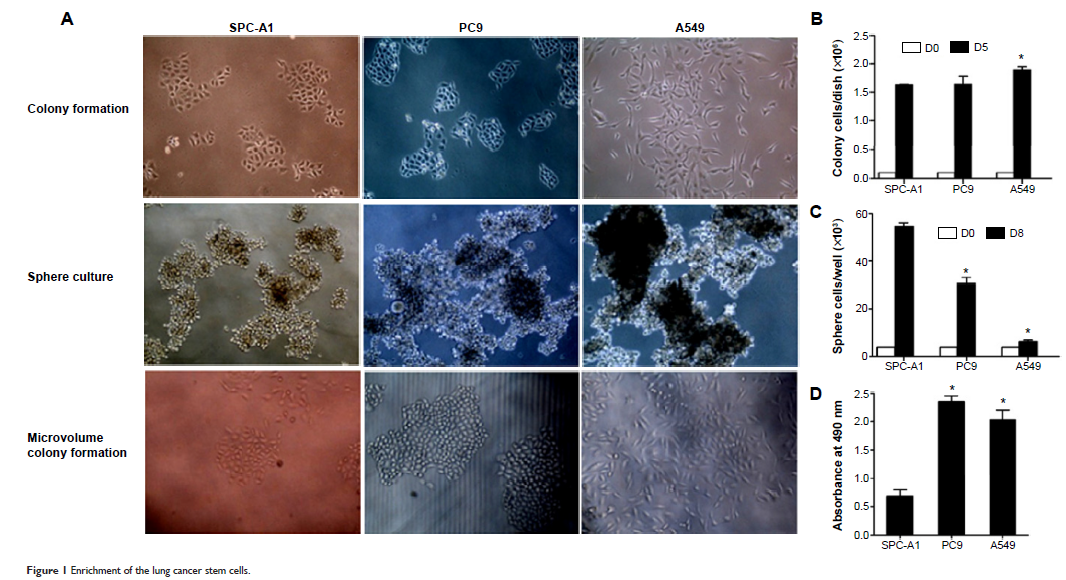109669
论文已发表
注册即可获取德孚的最新动态
IF 收录期刊
- 3.4 Breast Cancer (Dove Med Press)
- 3.2 Clin Epidemiol
- 2.6 Cancer Manag Res
- 2.9 Infect Drug Resist
- 3.7 Clin Interv Aging
- 5.1 Drug Des Dev Ther
- 3.1 Int J Chronic Obstr
- 6.6 Int J Nanomed
- 2.6 Int J Women's Health
- 2.9 Neuropsych Dis Treat
- 2.8 OncoTargets Ther
- 2.0 Patient Prefer Adher
- 2.2 Ther Clin Risk Manag
- 2.5 J Pain Res
- 3.0 Diabet Metab Synd Ob
- 3.2 Psychol Res Behav Ma
- 3.4 Nat Sci Sleep
- 1.8 Pharmgenomics Pers Med
- 2.0 Risk Manag Healthc Policy
- 4.1 J Inflamm Res
- 2.0 Int J Gen Med
- 3.4 J Hepatocell Carcinoma
- 3.0 J Asthma Allergy
- 2.2 Clin Cosmet Investig Dermatol
- 2.4 J Multidiscip Healthc

已发表论文
Wnt 拮抗剂抑制肺癌干细胞的增殖
Authors Zhang X, Lou Y, Zheng X, Wang H, Sun J, Dong Q, Han B
Published Date April 2015 Volume 2015:9 Pages 2399—2407
DOI http://dx.doi.org/10.2147/DDDT.S76602
Received 29 October 2014, Accepted 12 December 2014, Published 28 April 2015
Background: Previous study has confirmed that the occurrence of Wnt pathway activation
is associated with risk of non-small-cell lung cancer recurrence. However,
whether the pharmacologic blocking of the Wnt signaling pathway could provide
therapeutic possibility remains unknown. The aim of the present study was to
evaluate the therapeutic functions of the Wnt signaling pathway inhibitor
pyrvinium pamoate (PP) on lung cancer stem cells (LCSCs) in vitro.
Methods: Colony formation and sphere culture were performed to enrich LCSCs from three lung cancer cell lines: PC9, SPC-A1, and A549. After confirming stemness by immunofluorescence, PP was employed for cell viability assay by comparison with three other kinds of Wnt signaling inhibitor: salinomycin, ICG-001, and silibinin. The effect of PP on LCSCs was further verified by colony formation assay and gene expression analysis.
Results: LCSCs were successfully generated by sphere culture from SPC-A1 and PC9 cells, but not A549 cells. Immunofluorescence assay showed that LCSCs could express pluripotent stem cell markers, including NANOG, Oct4, KLF5, and SOX2, and Wnt signaling pathway molecules ß-catenin and MYC. Half-maximal inhibitory concentrations of PP on SPC-A1, PC9, and A549 were 10 nM, 0.44 nM, and 0.21 nM, respectively, which are much lower than those of salinomycin, ICG-001, and silibinin. Moreover, significantly decreased colony formation and downregulation of pluripotent stem cell signaling pathway were observed in lung cancer cells after treatment with PP.
Conclusion: Wnt signaling inhibitor PP can inhibit proliferation of LCSCs, and the Wnt signaling pathway could be considered a promising therapeutic or interventional target in lung adenocarcinoma.
Keywords: pyrvinium pamoate, Wnt signaling pathway, sphere culture, colony formation
Methods: Colony formation and sphere culture were performed to enrich LCSCs from three lung cancer cell lines: PC9, SPC-A1, and A549. After confirming stemness by immunofluorescence, PP was employed for cell viability assay by comparison with three other kinds of Wnt signaling inhibitor: salinomycin, ICG-001, and silibinin. The effect of PP on LCSCs was further verified by colony formation assay and gene expression analysis.
Results: LCSCs were successfully generated by sphere culture from SPC-A1 and PC9 cells, but not A549 cells. Immunofluorescence assay showed that LCSCs could express pluripotent stem cell markers, including NANOG, Oct4, KLF5, and SOX2, and Wnt signaling pathway molecules ß-catenin and MYC. Half-maximal inhibitory concentrations of PP on SPC-A1, PC9, and A549 were 10 nM, 0.44 nM, and 0.21 nM, respectively, which are much lower than those of salinomycin, ICG-001, and silibinin. Moreover, significantly decreased colony formation and downregulation of pluripotent stem cell signaling pathway were observed in lung cancer cells after treatment with PP.
Conclusion: Wnt signaling inhibitor PP can inhibit proliferation of LCSCs, and the Wnt signaling pathway could be considered a promising therapeutic or interventional target in lung adenocarcinoma.
Keywords: pyrvinium pamoate, Wnt signaling pathway, sphere culture, colony formation
